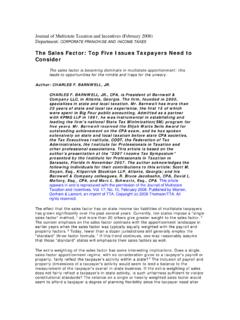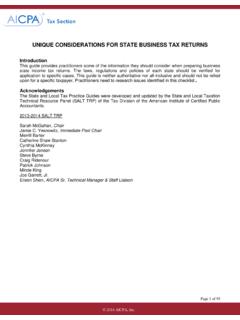Transcription of An Explanation of Combined Reporting - Maryland
1 1 Formatted: Right: 18 ptAn Explanation of Combined Reporting Combined Reporting is a method of apportioning the income of corporations among the states in which they do business. Under Combined Reporting , the related corporations that are part of a unitary group are generally treated as one entity for tax purposes. Supporters of Combined Reporting say that this grouping of corporations eliminates distortions and tax planning opportunities caused by intercompany transactions, whether legitimate or otherwise, within the group. Opponents say that Combined Reporting creates other distortions by attributing income to the wrong jurisdiction, because the calculation simply averages the income and apportionment of all the businesses that actually have different economic profitability.
2 Currently, Maryland is a separate entity state, where every legal entity that is a C-corporation files its own tax return, generally without regard to the activities or tax returns of related entities. Maryland has also enacted several anti-tax avoidance laws, most notably the addback for intercompany transactions (aka Delaware holding company ), the anti-captive REIT, and providing the Comptroller section 482 authority to adjust income and deductions. Because of the combining of apportionment fractions as well as income, and also the opportunity of blending losses with income, the Combined Reporting calculation will produce increased tax liability for some corporate groups and decreased tax liability for other corporate groups.
3 An example of the tax calculation under separate returns and Combined Reporting is as follows: Net Apportionment factors: Corporation Income in MD / Everywhere Parent $20,000,000 30,000,000 / 100,000,000 Subsidiary A 30,000,000 10,000,000 / 500,000,000 Subsidiary B 10,000,000 Zero / 400,000,000 Total group $60,000,000 40,000,000 / 1,000,000,000 Maryland Tax Calculation Separate returns.
4 Parent $20,000,000 x 30M/100M x = $495,000 Subsidiary A $30,000,000 x 10M/500M x = $ 49,500 Subsidiary B Zero apportionment (no Maryland business) 0 Group s total tax: $544,500 Maryland Tax Calculation Combined Reporting : Group s total tax: $60,000,000 x 40M/1,000M x = $198,000 2 Formatted: Right: 18 ptUnitary Group The first and most important step in the implementation of Combined Reporting is to define the characteristics of a unitary group. Conceptually, a unitary group is composed of those related companies whose business activities are interdependent.
5 The statutes and courts of the states that currently require Combined Reporting use varying definitions of unitary. Typically, some combination of centralized control, economies of scale, and a flow of goods, resources or services demonstrating functional integration is used to determine whether a collection of entities is a unitary group. These concepts may require subjective application to the detailed facts of particularly complicated cases. There have been many court cases across the states that demonstrate the complexities of the issues and the varied results even when applying identically worded statutes. A group of corporations will only be treated as unitary if there is a degree of common ownership among them; most states use a 50% common ownership threshold.
6 Combination may or may not be limited to C-corporations and may include certain passive investment companies and certain captive real estate investment trusts. Often excluded are corporations that are subject to a different tax rather than the corporate income tax, such as insurance companies. The multistate Tax Commission (MTC), in its model statute for Combined Reporting , defines a unitary business as a single economic enterprise consisting of either separate parts of a single business or a commonly controlled group of entities that are organized to provide synergy and mutual benefit through functional integration, centralization of management, and economies of scale. MTC regulations stipulate that a commonly controlled group is that group of corporations where the parent corporation, directly or indirectly, owns more than 50 percent of the voting power of the other corporations.
7 The MTC statute also requires the inclusion of pass-through entities to the extent of the corporation s distributive share of the pass through entity s income. Not all states use the MTC model statute. Corporate group is currently defined in Maryland law for purposes of corporate information Reporting . Insurers, regulated investment companies, and corporations that are not subject to federal income tax are explicitly excluded from a corporate group. One definition is based on federal definitions of affiliated groups (which, among other distinctions, requires 80% ownership) and controlled groups, while the other is essentially similar to the MTC regulations. Many states also include a provision explicitly allowing the tax administrator to adjust the membership of a unitary group to more appropriately reflect unity.
8 Determining the unitary group members may involve imposing geographic limitations, which affects the handling of foreign income and apportionment factors. This decision is commonly referred to as worldwide vs. water s edge. Worldwide Reporting is exactly what it sounds to be: inclusion of the unitary group s entire worldwide income and apportionment factors, regardless of the source, whereas water s edge Reporting includes, 3 Formatted: Right: 18 ptwith some exceptions, only entities with significant business operations within the United States. Worldwide Unitary Arguably, if a group is unitary, jurisdictional borders should be irrelevant. The group s income can be summed and apportioned without regard to domicile or source of income.
9 In practice, this concept becomes less straightforward. Although the worldwide concept has been upheld in the Supreme Court, worldwide without a water s edge election option has remained unpopular and mostly unused by the states (only Alaska requires worldwide combination and only for the oil industry). A 1984 report to President Reagan from the Secretary of the Treasury following the work of the Worldwide Unitary Taxation Working Group states that the worldwide concept is very unpopular with multinational businesses and foreign governments for several reasons, including: that this method of taxation leads to state taxation of foreign source income and is at variance with the internationally accepted separate accounting method for avoiding double taxation.
10 Lump[ing] together income earned in numerous profit centers throughout the world and then divid[ing] the result on a formula basis distorts the attribution of income to any particular source or state since in some centers losses are incurred, while in others profits result; that distortion occurs because no deduction is allowed for foreign taxes or other payments to foreign governments; and that use of the method imposes substantial administrative burdens because of the need to translate accounts of their entire foreign operations into currency and to conform them to and state accounting rules; they note that there is no other requirement for such Reporting by foreign nationals.






